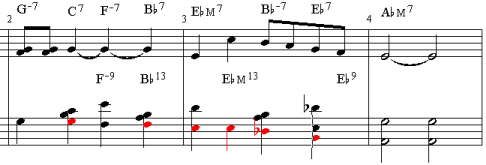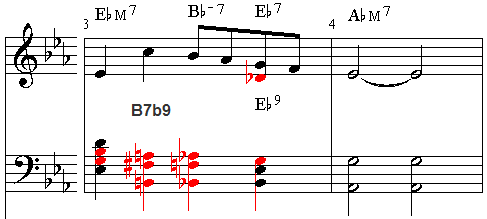We are moving forward with adding chord tones to the arrangement in measure 3. I indicated last time that I was experimenting with this chords in this measure and decided to consider something similar to what we did in measure 1 with half step leading voice.
Getting Crazy in Measure 3
I tried a few different things. So instead of going forward and maintaining the smooth bass line choices we had before I got a little crazy and did something else. This is pushing the envelope but it's a great example of auditioning ideas.
Here's where we started.

And here's what I did. Beat 1 I filled in the two other chord tones. You should know the intervals by now. Now this is where I got nuts.
Since beat 3 is a Bb and close to the Ab where we want to end up in measure 4. I set the root Bb down an octave from where we initially started. I left the Ab in place and added an F (5th).

I then went back to beat 2 and came in a half step below the Bb at B natural and then added the 5th and 7th interval chord tones. This creates a bit of a jump in the bass line at this point, but I'm thinking it's going to be worth it. Can you also see why I called it a flat 9. I'm challenging your ear on this one.
In the 4 beat I moved the Db up to the treble clef where it would be easier to play in the right hand and added a 3rd to the chord to make a Eb 2nd inversion.
Looking at the Music Theory in Measure 3
I like this flow of chords and want to look at the progression a little closer to see what is going on from the music theory point of view.
The EbM7 moves to B natural where I had considered going to an F chord. The B is a tritone movement (#4 or b5) away from the F, this is a great substitution for dominant chord movement (V7 to I or i). So in this case we instead of going to an F7 then to Bb-7 we went to the tritone substitution and half stepped down into the Bb-7.
From this point we have a tight bass line from B to Bb to Ab to get us to the end of the phrase. But notice the individual note movements as well as the top notes move in half or whole step increments.
Also look at what we did with the ii7, V7, IM7 chord progression. The Bb-7 is a root-5-7 moving nicely to a Eb 2nd inversion, to a AbM7 at root -7, I think I'll add a 3rd in here either in the treble clef or bass as we move forward to try that out.
Next time I'll start a deeper look at adding and rearranging notes in the treble clef to add additional richness to the arrangement.